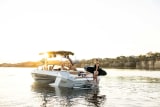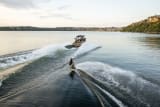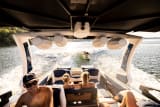COMPLETE GUIDE TO WAKESURFING
While tubing, waterskiing, and wakeboarding will likely forever be favorite pastimes behind the boat, it’s wakesurfing that has truly grabbed the collective attention of watersports fans in recent years.
Relatively easy for all ages to learn and delightfully gentle on the body, wakesurfing is a sport that multiple generations can enjoy together. It’s also just one heck of a lot of fun, bringing the thrills of ocean surfing to lakes and rivers far from any coastline.
The Beach Boys once claimed that if everybody had an ocean we’d all be surfing. Thanks to boats with inboard propulsion and innovative ballast and wake-generation systems, that ocean is now as close as your nearest waterway.
What is wakesurfing?
Make no mistake, wakesurfing is actual surfing. The difference is that instead of Mother Nature providing the wave, it’s the boat’s wake that does the work.
The start is similar to wakeboarding. Riders are pulled from a deep-water start via a short towrope and use similar edge-to-edge weight shifts to maneuver the board to the left or right. Unlike wakeboarding, however, once you find the sweet spot a towrope is no longer necessary. Riders can carve and slash on an endless wave for as long as their legs, balance, and friends on the boat will allow.
Getting Started
While wakesurfing shares many similarities with wakeboarding, there are several key differences when it comes to equipment that will ensure you get up riding both quickly and safely.
The Boat
Start with the boat.
When it comes to wakesurfing, not all boats are created equal. Many, in fact, are simply not safe to use due to the exposed location of their propeller. Both outboard and sterndrive models fall into that category. The ideal wakesurf boat is an inboard, whether in a direct or V-drive configuration. Inboards tuck the propeller far up under the hull, away from a rider surfing in close proximity to the transom.
Wake-specific inboards also feature the latest technology to boost and shape the wake. Built-in, onboard ballast bags or tanks can be filled with water to weigh the hulls down, settle the boat deeper in the water and, in turn, boost the wake’s volume. Innovative hardware like Tigé’s TAPS 3T system further increases the wake’s size with just a touch of the GO System on the boat’s dash-mounted touchscreen, while adding the shape and curl surfers long for.
The Board
While early wakesurfers used traditional surfboards to ply the wakes, as the sport has evolved boards have changed to better take advantage of a boat’s unique wake.
Surf-style boards offer a ride most similar to ocean surfing. Longer boards are great for beginners or those who prefer a more laidback vibe, while shorter boards allow more aggressive riders to carve, slash and even jump.
Shorter, thinner skim-style boards, meanwhile, are ideal for technical spin tricks.
Both styles come in a variety of shapes and lengths designed to fit all surfing styles and abilities. Longer, wider boards are typically ideal for beginners as their larger surface area offers added stability. Shorter boards may not be as stable, but their length offers increased agility and quicker response to a rider’s input.
In general, the best results will be achieved starting with a longer, surf-style board and then, if you want a more aggressive ride, graduating to shorter, more responsive shapes. Or, try a hybrid shape that combines the best attributes of both styles.
The Rope
Don’t be tempted to use the typical wakeboard or ski towrope when wakesurfing.
For starters, they’re too long. The sweet spot for wakesurfing is often only 10'-15' behind the boat; ski and wakeboard ropes often stretch to 75'. Wakesurf-specific towropes are far shorter (15' - 20'), and avoid the large handles and yokes that could entangle a rider’s arms or even legs in a fall.
These short, small-handled ropes are also easier to toss aside and have boat passengers pull back aboard when a rider is ready to surf with only the push of the wake.

The Technique: How to get up wakesurfing
Getting up on a wakesurf board is similar to wakeboarding.
Start by laying in the water, board floating flat and perpendicular to the boat and the nose on the side of what will be your forward foot. If you’re already a board rider, mimic your wake, skate, or snow stance. If you’ve never participated in other board sports, have a friend gently push you from behind while standing on the dock. The foot you put out to catch yourself will likely feel most comfortable in the forward position on the board.
Place your heels on top of the board, about a shoulder’s width apart, choosing a position that, once up and riding, will have your feet relatively even along the board’s centerline. Once ready, signal the driver to put the boat in gear and gently push down on your heels, keeping arms straight and letting your butt slide forward toward the board. The pressure of the water against the bottom of the board will push it up against your feet and hold it in position. Your arms straight, tucked body posture will allow the boat to do all the work and pull you easily atop the water.
Once the board planes, stand up, keeping knees slightly bent, and bring your lead hip to the tow handle, allowing the board to naturally pivot parallel with the towboat. Once you maneuver over the whitewater hump created by the building wake, let go of the towrope handle with your rear hand. Most riders will prefer to face the wake, so keep your knees over your toes to put more pressure on the board’s topside edge, or rail, to stay in position.
Spend a while getting used to how the board responds. A good analogy is to think of your front foot as the gas pedal and your back foot as the brake. More weight on the forward foot will accelerate the board forward, while more weight on the back foot will slow the board’s speed. Use these front foot/back foot weight shifts, along with changes in your heel or toe pressure, to maneuver the board forward and back, and from side to side, until you find the sweet spot — the position where the towrope goes slack and the wake alone is naturally pushing you forward.
Practice staying within this sweet spot until you’re comfortable with your balance and how the board responds. When you’re ready, toss the rope aside (a helper aboard the boat will quickly reel it in)…and you’re wakesurfing!

Driving the Wake Boat
Remember, the driver plays a role in the wakesurfer’s success.
Avoid a heavy hand on the throttle, particularly at the start. Wakesurf boards have a large surface area and will easily plane atop the water, so there’s no need for excessive speed. Instead, accelerate smoothly to about 10-12 mph. As the boat will not be on plane, it may be a hard speed to maintain. GPS-based, electronic speed controls do a far better job than a human hand on the throttle.
While it’s tempting, don’t turn to check out the surfer in tow. As the driver, your job is to pick a safe, obstruction-free path. Quick checks in a rearview mirror are fine, but rely on the spotter to relay any hand signals from the rider or alert you in the event the rider falls.
Be aware of the effects your pumped-up wakes have on other boaters. Stay at least 200 feet away from land, docks, and other boats and try not to run the same repetitive path. Find the boat wandering? Choose a landmark on shore to use as a target. It will keep the wake a consistent shape for the rider.
And remember, when returning to a downed wakesurfer, wakeboarder, or any other person in the water, always approach at idle speed and on the driver’s side to maintain a constant view of the person in the water.

Build the Perfect Wave
Building the perfect wave is the result of carrying extra weight onboard, finding the ideal speed, and ideally, using transom-mounted hardware to affect the boat’s running attitude.
Weight can be as simple as gathering a large group of family or friends. Additional weight in the boat can be provided by water ballast bags or even lead plates. Position much of the weight at the stern to the side your rider is wakesurfing on, but experiment with weight in other locations, like the bow, to more evenly settle the hull in the water and observe how it affects wake size.
The ideal setup is onboard, internal water ballast bags or tanks, plumbed so that they’re easily filled and emptied at just the touch of a button…or in the case of Tigé’s GO System, a simple tap on a touchscreen. Internal ballast bags or tanks are often hidden below the floor so as not to steal precious cockpit space. When plumbed to electronically controlled pumps, they can also be filled or emptied to varying capacities to fine-tune the wake to the surfer’s preferred size and shape.
Speed will affect the wake’s size and shape. While most riders will likely find 10-12 mph provides the best results, again, experiment to find a rider’s ideal setting. Electronic speed control systems provide the best results. Once the rider finds that ideal speed, the driver can simply lock it in and let the boat’s onboard computer keep it at the desired setting.
As to transom hardware, wakesurf-specific boat models typically feature transom-mounted, electronically actuated plates like Tigé’s TAPS 3T to truly fine-tune wake size and shape. The best part? Integrated setups like Tigé’s GO System powered by TAPS 3T dial in all three — ballast, speed, and wake-enhancing hardware — with just a tap on the GO screen, simplifying setup and getting you quickly on the water.

How is wakesurfing different than wakeboarding?
There are several things that make wakesurfing and wakeboarding two separate sports. While at first glance they look fairly similar (and in fact share similar starting and edging techniques), on closer inspection key differences are obvious…and just may affect which of these wake disciplines you prefer.
Most obvious? A wakeboarders’ feet are strapped to the board they’re riding. This offers added leverage and stability and really pays off when attempting aerial tricks, but it limits the foot positions and freedom of movement a surfer enjoys with just their bare feet free to move about the board’s surface.
Wakeboarding and wakesurfing also happen at very different speeds and within different proximity to the towboat. Wakeboarders often ride between 18-24 mph and 65’ or more behind the boat, where the wakes are widely spaced and shaped to the ideal launch ramps. Wakesurfing, in contrast, typically happens at a much slower 10-12 mph and in very close proximity to the boat’s swim platform where the peak of the wake is at its greatest height.
The good news? Many of the skills required by each is transferable to the other. That’s probably why so many riders enjoy both!

Wakesurfing Safety
Always wear a properly sized, Coast Guard-approved life vest any time you’re participating in a towed watersport. In most areas, it’s the law.
While serious falls when wakesurfing are a rarity (in part thanks to the slow speeds at which wakesurfing takes place), accidents can happen. In the unlikely event of an injury, it’s best to have a life vest’s assistance to keep you afloat and head above water until the boat can return and passengers provide help. Added benefit? That same buoyancy that will keep you afloat after a fall is also welcome during the starting process when a rider is laying in the water waiting for the boat to get into position and accelerate.
As to the crew in the boat, designate one passenger to serve as a spotter. Position that person in the passenger seat, facing backward, and make sure he or she has an unobstructed view of the rider. It’s the spotter’s job to keep an eye on the rider at all times, relay the rider’s signals to the driver and alert the driver immediately in the event of a fall.
In some states, spotters are also required to hold up a flag any time the rider is down and in the water in order to alert nearby boats. Check local and state laws to see what’s required in your area.
